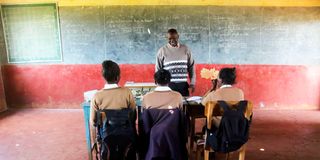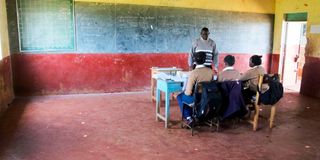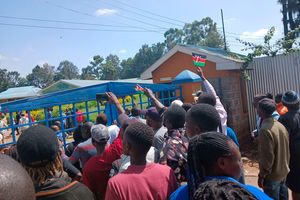
Michael Thimba, Principal of Kanjora Secondary School in Nyeri, engages the Form Three students on February 25, 2025.
Inside a Form Three classroom at Kanjora Secondary School in Nyeri County, three girls huddle closely together in quiet solidarity, as though drawing comfort from one another.
The three are not just classmates, but form the entire population of the school. There are usually five but two of their colleagues are absent. The institution had, at one time, an enrolment of over 200 learners but is now on its deathbed.
Across the compound, chairs lie abandoned, and dusty lockers piled up high. While the day school nestled in the heart of Tetu Sub-county breathes in solitude, it is not in ruins.
The classrooms are well-equipped and laboratories brim with potential. A newly constructed administration block, funded by the Tetu National Government Constituency Development Fund (NG-CDF) in 2020, IS gleaming in the quiet. The resources are there, but learners are missing.
Kanjora Secondary School is not an exception in the Mt Kenya region where facilities and resources are going to waste. Several sub-county schools the Nation team visited revealed a sorry state of affairs.
The schools are staffed by the Teachers Service Commission (TSC) but are grossly under-enrolled. Teachers spend time lazing around while others do not turn up at all.

Michael Thimba, Principal of Kanjora Secondary School in Nyeri, engages the Form Three students on February 25, 2025.
Mugwandi Mixed Day Secondary School in Kirinyaga came into the limelight two months ago after the revelation that the entire institution had only one Form Two student and eight teachers.
The school has since been shut down indefinitely and the teachers transferred while the student was moved to a neighbouring school.
According to the principal of Kanjora Day School Michael Thimba, the institution has five teachers and five students, all in Form Three. Last year, the Kenya Certificate of Secondary Education (KCSE) candidate class had only 10 candidates. When they left, only the Form Three class remained.
“We were left with the Form Two class (presently Form Three). Our last Form One intake had about 40 students, but they slowly trickled away, one by one,” Mr Thimba said, adding that, at one time, the school had more than 200 students.

Form Two students in a lesson at Gakere Secondary School, Nyeri County, on February 4, 2025.
According to the principal, many students drop out to work as casual labourers on tea and coffee farms. Despite high enrolment in nearby public primary schools, local secondary schools remain deserted.
For example, Kagonye Primary School, just across the fence has 400 learners while Ihururu Primary School has over 500 learners.
The dying schools phenomenon is familiar at Gakere Secondary School in the same sub-county. There are only 55 students and the school principal Mr Samuel Kiragu says that during the Form One admission last year, the day school was allocated only four students who were all from outside the county.
“We could not admit them because we are a day school. That year, we had to invest heavily in marketing to persuade local parents to enroll their children here. Now, we’re proud to have a Form Two class of 25 students,” he says.
About 20 kilometres away in Othaya Sub-county, seven secondary schools are facing a similar crisis. For the first time, Kairuthi Secondary School, a sub-county boarding school, will not have any KCSE candidates this year after transferring its last candidate to a neighboring school.
At Kihome Secondary School, another sub-county school that was initially triple-streamed, enrolment has shrunk to just one stream per class, with a total student population of only 124.
A TSC official, who sought anonymity as she is not allowed to speak to the media, revealed that low enrolment in day secondary schools is confined to Nyeri County.
Among the counties in Central Kenya – Kiambu, Kirinyaga, Murang’a, and Nyandarua – Nyeri is the hardest hit, largely due to its shrinking population.
“We have observed that the challenge starts at the Early Childhood Development Education (ECDE) level, where enrolment is low. This issue has gradually impacted primary schools, and as a result, a small number of primary schools are feeding into a much larger pool of secondary schools, creating a significant imbalance,” the official explained.
She added that Nyeri, once a prosperous agricultural hub, has shifted into a business centre. However, many locals have migrated to other counties, and the local economy is no longer as robust as it once was.
“Only day schools in urban centres are performing well, as they mostly serve children of workers involved in the local businesses,” she said.
In contrast, Kirinyaga and Nyandarua have high enrolment numbers, as they are still farming counties. Kiambu, on the other hand, has witnessed an increase in enrolment at day secondary schools, mainly due to its proximity to Nairobi, attracting a significant number of non-locals.
In Tharaka Nithi County, the situation is similar. For about one year, seven teachers at Nyagakairu Primary School in Rubate, Chuka/Igambang’ombe have been reporting to work but the classrooms are empty.
Located 15 kilometres from Chuka town along Kirubia – Kambandi – Chera – Itugururu Road, Nyagakairu, the primary school has been in operation and thriving since 1991.
However, according to residents, for the last four years, the enrollment has plummeted. We drive through easily since there is no gate. We encounter tall overgrown grass surrounding deserted classrooms.
The signboard at the entrance is bent into the bushes in an attempt to cover the shame of a school that once hosted over 350 learners. As we disembarked from our vehicle, three learners in pre-primary excitedly welcomed us. However, the teachers who were basking in the sun scatter on discovering we are journalists.
Some two teachers, unbothered by our arrival, busily hurl stones at a mango tree as they seek to quench their thirst for the juicy fruits. One of the teachers ushers us into a building that hosts a dusty staffroom and office with no furniture.
Residents also say the absence of a junior school at Nyagakairu was the final blow as parents prefer taking their children to comprehensive institutions.
Ms Karegi, a resident, blames the collapse of the school on poor management and inaction by the government.
However, a Ministry of Education official who did not want to be quoted blamed the situation on population decline in the area.
“The ministry standards recognise any school with at least 10 learners. We have a situation in that area where there are too many schools for a small population. As a ministry, we cannot do much other than close the school and secure public property if stakeholders fail to bring in learners,” the official said.
Tharaka Nithi director of education Brigit Wambua said most of the learners had transferred from Nyagakairu primary school and blamed the situation on too many schools in the area.
She said there are many primary schools in Tharaka Nithi County with enrolment of less than 20 learners. The director cited Kandega Primary School which has 17 learners, Kiegoti (14), Kamatanga (12), Iruri (19), and Kariani (10) while Ntharuni Secondary School in Chiakariga has no learners at all.
“The community has developed many schools near each other. This is a growing trend and what we can do as a ministry is safeguard public property because it is very uneconomical to run such schools,” Ms Wambua said.
She said the management of teachers is a mandate of the Teachers Service Commission. An education official in Nyeri who also spoke on condition of anonymity attributed the crisis to larger schools absorbing most of the learners and depriving smaller secondary schools.
“Last year, national and extra-county schools admitted double or even triple their usual numbers, anticipating the absence of Form One enrolment this year, crippling sub-county schools as they are the lowest in the tier,” he said.
According to Nyeri County Kenya Union of Post Primary Education Teachers (Kuppet) executive secretary Moses Wanjiku, the decline in enrolment in sub-county schools is due to a lack of community support and uneven distribution of learners among schools.
“Last year, some schools admitted an overwhelming number of students, while others struggled. Many learners who would have gone to sub-county schools were instead absorbed by county and extra-county institutions,” he explains.
Reported by mercy Mwende, David Muchui and George Munene










